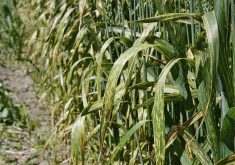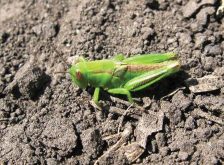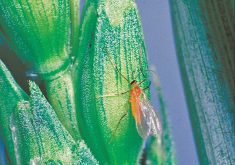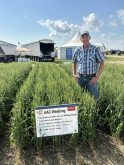Planting saved soft white spring wheat that’s tolerant to wheat midge comes with a multimillion-dollar risk.
If tolerance is lost, it could cost growers $60 million annually and up to $36 per acre, said Mike Espeseth, co-chair of the communications committee of the Midge Tolerant Wheat Stewardship Team.
A single gene, called Sm1, provides midge tolerance. First identified in soft red winter wheat varieties, it took breeders more than 15 years to cross the naturally occurring trait into red spring wheat, with the first varieties released in 2010.
Read Also

Mosquito-borne virus could be devastating to sheep breeding operations
Cache Valley virus, a mosquito-borne disease that infects small ruminants, could be a devastating hit to small operations.
But it was recently found the Sm1 gene is naturally occurring in the majority of soft white spring wheat varieties. And that’s a problem because some midges are naturally tolerant to the Sm1.
“The Sm1 gene is the only known source of midge tolerance,” said Espeseth, whose organization is a broad coalition of breeders, government, seed growers, and producer groups.
“We all know that stewardship is important. We want the growers to know that we’ve got to protect that Sm1 gene because it’s all we’ve got for tolerance for midge.”
To avoid that scenario, farmers seeding midge-tolerant wheat need to adhere to a critical stewardship practice.
“Anybody who buys midge-tolerant wheat is required to sign a stewardship agreement saying they won’t use farm-saved seed one generation past certified. And that’s to keep the refuge at that 90/10 level,” said Espeseth.
All midge-tolerant wheat is sold as a varietal blend composed of 90 per cent that is tolerant and 10 per cent that isn’t.
“It’s called an inter-dispersed refuge system and that disrupts the midge’s ability to produce resilient offspring. Eventually the midge will be able to overcome that resistance. Having it sold at 90/10 split is thought to extend the life of the Sm1 gene for that much longer.”
A short video explaining how a refuge leads to resistant midge population can be found at www.midgetolerantwheat.ca. The website also has a list of resistant varieties, which includes soft white spring varieties such as AAC Chiffon, AAC Indus, AC Sadash and AAC Paramount as well as Canada western general purpose varieties such as AAC Awesome.
“All the growers who were growing those varieties were asked to start following stewardship practices and get soft white seed with the refuge added,” said Espeseth.
Producers can either source certified seed with the refuge added or add a refuge variety, AC Andrew, to their existing supply. One bushel of AC Andrew to every nine bushels of tolerant soft white spring variety provides the necessary refuge. Farmers unable to source seed or add the refuge should spray insecticide to eliminate the possibility of resistant midge.
The website also has a tool for seed distributors and seed retailers.
“All the midge-tolerant agreements are now online and they are evergreen, which means that you just have to sign it once,” said Espeseth.
Farmers should go to the website and talk to their seed growers about midge-tolerant wheat, he said.
“It’s on the whole industry to protect this tool,” he said.
Alberta Agriculture’s 2018 wheat midge forecast says the risk is low in the Peace region and the south, with a higher concern for parts of central Alberta.
But farmers need to “assess their risk based on indicators specific to their farm,” said the department’s website.
“Specifically, producers should pay attention to midge downgrading in their wheat samples and use this as an indication of midge risk in their fields,” it states.
















